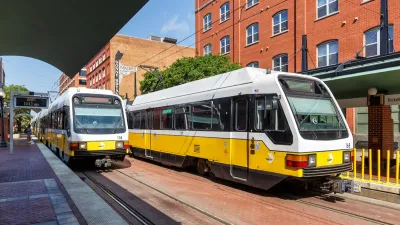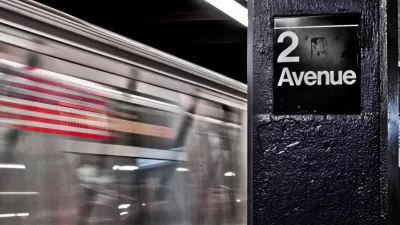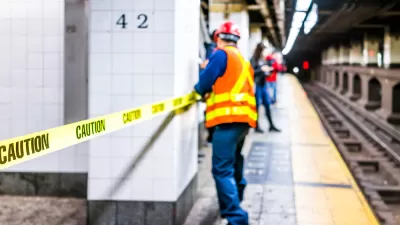One of the most important officials in New York State transportation history died Oct. 15: William J. Ronan, who took on Robert Moses to form the country's largest, most diversified transportation agency, the Metropolitan Transportation Authority.
"With the blessing of Gov. Nelson A. Rockefeller, whom he long served as a close aide and adviser, Dr. Ronan engineered the state’s takeover of the Long Island Rail Road [from the Pennsylvania Railroad] and then outmaneuvered Robert Moses, the master builder of highways, bridges and parks, to secure the takeover of the Triborough Bridge and Tunnel Authority and the New York City Transit Authority," writes Sewell Chan, deputy editor of The New York Times with contributions from Daniel E. Slotnik.
Mr. Rockefeller and Dr. Ronan pushed for a regional transportation agency over the objections of Mr. Moses, the chairman of the profitable bridge and tunnel authority. He described the plan as “grotesque” and “absurd.” Mayor John V. Lindsay also opposed the state takeover of the city’s subways. But Mr. Rockefeller and Dr. Ronan prevailed, and the Metropolitan Transportation Authority was born on March 1, 1968.
Initially "(c)hartered by the New York State Legislature in 1965 as the Metropolitan Commuter Transportation Authority" per Wikipedia, it dropped "commuter" from its name three years later when it took over operations of New York City's buses and subways and many bridges and tunnels in the New York City region. In 1983, it took ownership of what is now Metro-North Railroad. All operations are listed in their website.
The agency allowed for highway tolls to subsidize (transit operations), guaranteeing a bountiful stream of money that remains the linchpin of the region’s mass transit financing.
You'd think New Yorkers would be grateful to Ronan for making transit financially sustainable by putting it under the authority of the state and allowing for motorists to subsidize its operations—but this being New York, "Dr. Ronan became the face of the transit system and the target of riders’ frustration" as its chairman. "He was the subject of subway graffiti, and angry Long Island commuters hanged him in effigy," writes Chan.
“We’re making up for 30 years of do-nothingism in mass transportation,” he said in a 1968 interview.
“I was at one point probably the most hated man in New York,” he recalled in a 2005 interview for this obituary, writes Chan after Ronan approved a 10-cent increase in the subway fare (from 20-cents) in 1970.
Even today, New York's two biggest transportation projects can be traced to Ronan.
He laid out an ambitious expansion agenda that called for a subway line under Second Avenue, a connection from the Long Island Rail Road to the East Side of Manhattan and the construction of a new subway tunnel under 63rd Street. The first two projects, long dormant, were revived in 2000 and are under construction; the third project was completed in 2001.
Ronan died on Oct. 15 "at his home in West Palm Beach, Fla. He was 101," writes Chan.
FULL STORY: William J. Ronan, Architect of the Metropolitan Transportation Authority, Dies at 101

Study: Maui’s Plan to Convert Vacation Rentals to Long-Term Housing Could Cause Nearly $1 Billion Economic Loss
The plan would reduce visitor accommodation by 25,% resulting in 1,900 jobs lost.

Alabama: Trump Terminates Settlements for Black Communities Harmed By Raw Sewage
Trump deemed the landmark civil rights agreement “illegal DEI and environmental justice policy.”

North Texas Transit Leaders Tout Benefits of TOD for Growing Region
At a summit focused on transit-oriented development, policymakers discussed how North Texas’ expanded light rail system can serve as a tool for economic growth.

Paris Bike Boom Leads to Steep Drop in Air Pollution
The French city’s air quality has improved dramatically in the past 20 years, coinciding with a growth in cycling.

Why Housing Costs More to Build in California Than in Texas
Hard costs like labor and materials combined with ‘soft’ costs such as permitting make building in the San Francisco Bay Area almost three times as costly as in Texas cities.

San Diego County Sees a Rise in Urban Coyotes
San Diego County experiences a rise in urban coyotes, as sightings become prevalent throughout its urban neighbourhoods and surrounding areas.
Urban Design for Planners 1: Software Tools
This six-course series explores essential urban design concepts using open source software and equips planners with the tools they need to participate fully in the urban design process.
Planning for Universal Design
Learn the tools for implementing Universal Design in planning regulations.
Smith Gee Studio
Alamo Area Metropolitan Planning Organization
City of Santa Clarita
Institute for Housing and Urban Development Studies (IHS)
City of Grandview
Harvard GSD Executive Education
Toledo-Lucas County Plan Commissions
Salt Lake City
NYU Wagner Graduate School of Public Service




























